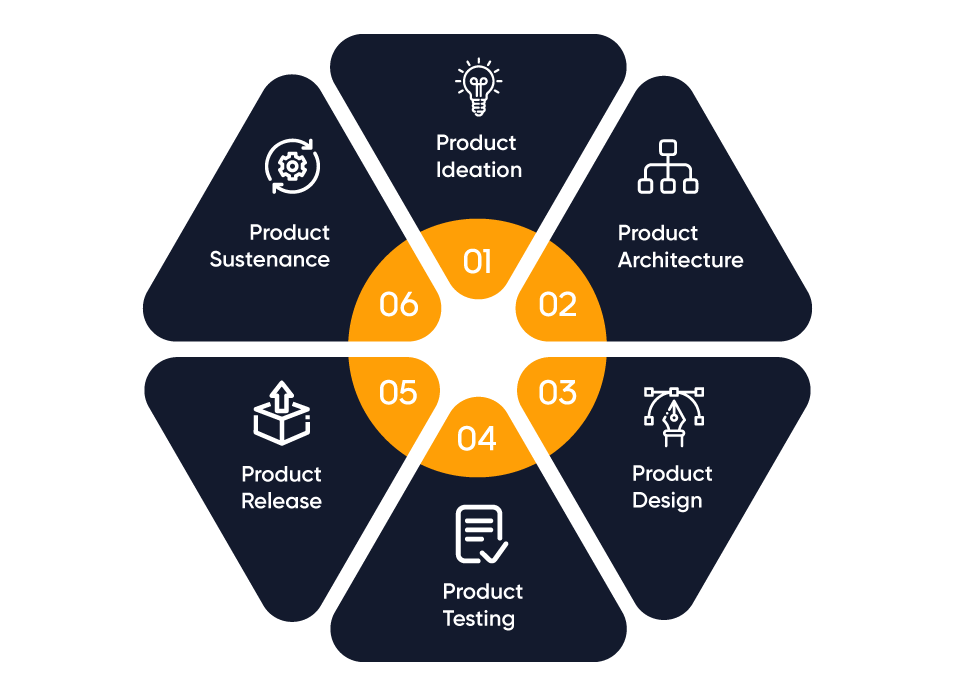Embedded software is everywhere. Your phones, TV, and alarm systems all contain embedded software. Embedded software is software that is built on different devices or machines. It utilizes a dedicated function in the device. This kind of software runs on a device with a built-in operating system.
In this article, we will discuss what is embedded and what an embedded software product engineering process looks like.
Embedded software is a type of software that is programmed into hardware devices. For example, GPS devices, robots, calculators and smartwatches use embedded software. The integration of software engineering with these devices allows them to develop systems comprised of programming tools and operating systems.
The world is increasingly relying on technology to function, and as a result, the demand for embedded software product engineering has grown exponentially. This software product engineering is responsible for creating apps that can handle the complex web of interconnected devices. The demand for these engineers will only grow as technology continues to develop.
Embedded software engineering is also popularly described as application-specific software designed to perform particular tasks repeatedly without user intervention. The specific device constraints embedded software it runs on, whereas application software has more freedom to utilize resources.
Embedded software product engineering positively impacts real-time operations in various settings to connect with the internet of things.
Related Read: Importance Of Software Product Engineering

Let’s see what stages any embedded software product development should go through:
This is the initial phase where an idea is discussed with all the stakeholders and brain-stormed to conclude if it is worth taking to the development stage. Then, market information is collected from online research, interviews with potential users, prospects, other market stakeholders, etc.
The ideation process concentrates on the problems the product will solve for the users. For example, all the features of the products could be categorized into needs, good to have and luxury. The more you focus on solving urgent needs, the better the response from the market will be for your product.
The team then has to move forward with finalizing the detailed technical specifications. It leads to developing the architecture of the product. Various aspects, such as how the product will look, what strategies will be used to build the product, and how the framework will look, are to be decided.
Related Read: A Guide To Minimum Viable Architecture Points For Any Startup
Once the architecture is done, product engineers need each aspect of the system, select the components, and finalize the design. This stage deals with the entire product design, considering requirements and concentrating on ‘how’ the product can achieve the required functionalities.
In this stage, the plan is transformed into a viable product. This phase is the heart of embedded software product engineering. It initiates the development of a document into an actual product. As it is the core of the process, this stage takes the longest time to develop compared to other stages.
Hardware and software testing is crucial to check the product’s reliability. For any embedded product testing, you need to define the testing plan; it should have the following components;
After the product is tested, you will know exactly how your product performs.
Before launching the product, many other things must be put in place beside the product. Various industry standards are to be tested, and setting up the support channel will help in the smooth launching of the product. You may try the market with a minor product launch. Further changes can be implemented depending on the outcomes.
Sustainability in the product will ensure the software is available in the future, on new platforms and meet unique needs. Re-engineering provides the embedded product that is easy to evolve, satisfies the intent, survives uncertainty and supports relevant concerns. This stage also includes modifications to the product whenever needed.
Embedded software product engineering offers a range of benefits for organizations involved in developing software for embedded systems. Let’s explore some benefits of engaging in embedded software product engineering.
Embedded software product engineering allows for customized solutions that meet the specific requirements of the target embedded system. This ensures the software is optimized for the intended application, improving performance, efficiency, and reliability.
By leveraging embedded software product engineering, organizations can increase their productivity. The development process is streamlined, and teams can focus on creating software solutions specifically designed for embedded systems. This targeted approach improves efficiency and accelerates the overall development cycle.
Embedded software product engineering enables organizations to unlock the full potential of their embedded systems. By leveraging the capabilities of the hardware components, the software can be developed to provide enhanced functionality, enabling the system to perform complex tasks and meet specific user requirements.
Embedded software product engineering allows for the optimization of software to work seamlessly with the hardware components of the embedded system. This results in improved performance, as the software can efficiently use system resources and take advantage of specialized hardware features.
Developing software specifically for embedded systems through embedded software product engineering can lead to cost savings. By tailoring the software to meet the system’s requirements, unnecessary features or functionalities can be eliminated, reducing development costs and ensuring optimal resource utilization.
Reliability is critical to embedded systems, as they are often used in safety-critical applications. Embedded software product engineering focuses on creating robust and reliable software solutions that can withstand demanding conditions and provide consistent performance over extended periods.
Embedded software product engineering allows for scalability and adaptability. As technology evolves and system requirements change, the software can be easily modified and upgraded to accommodate new features, hardware advancements, and evolving user needs. This ensures the embedded system remains relevant and can be adapted to future demands.
Specific industries, such as automotive and medical, have stringent regulatory requirements. Embedded software product engineering ensures the software meets the necessary regulatory standards and guidelines, ensuring compliance and facilitating the certification process.
Engaging in embedded software product engineering offers numerous benefits, including tailored solutions, increased productivity, enhanced functionality, improved performance, cost savings, increased reliability, scalability and adaptability, and regulatory compliance. By leveraging these advantages, organizations can develop high-quality software solutions that maximize the potential of embedded systems and meet the evolving needs of their target markets.

Embedded software product engineering is the process of developing software programs that are directly in the hardware. You can hire software product engineering services to implement the whole process efficiently.
At Mindbowser, our experts will guide you in every development step and ensure a higher quality product for your users. The experts understand the users and their needs and develop a strategic plan for best practices.
With our digital product engineering services, you can leverage their experience and knowledge to enhance your embedded software product development and deliver a successful solution to the market.
Embedded software engineering is crucial as it enables the functionality and performance of embedded systems. It ensures that the software on these systems is optimized for efficiency, reliability, and real-time responsiveness. Embedded software engineers play a vital role in developing systems used in critical applications such as medical devices, industrial automation, and automotive electronics.
Some key challenges in embedded software product engineering include optimizing performance for resource-constrained environments, ensuring real-time responsiveness, managing hardware-software integration, addressing security vulnerabilities, and maintaining compatibility across different hardware platforms.
Embedded software product engineering is essential because it enables software development specifically tailored to run on dedicated hardware platforms. It allows for efficient utilization of system resources, real-time responsiveness, and customization for specific industry needs, such as automotive, medical devices, IoT, and industrial automation.
Embedded software product engineering directly impacts the user experience as it influences embedded systems’ performance, reliability, and functionality. Well-designed and developed software can enhance user satisfaction by providing seamless operation, intuitive interfaces, and robust functionality in various applications, ranging from consumer electronics to industrial machinery.
Ensuring software security in embedded software product engineering involves implementing secure coding practices, conducting thorough vulnerability assessments, applying encryption and authentication mechanisms, managing access controls, and staying updated with security patches and updates. Addressing potential security risks to protect the embedded system and user data is essential.
Some future trends in embedded software product engineering include increased use of artificial intelligence and machine learning in embedded systems, the integration of edge computing capabilities, advancements in security measures, improved interoperability among different embedded systems, and the emergence of new applications in areas such as autonomous vehicles, smart cities, and healthcare devices.
Leave your competitors behind! Become an EPIC integration pro, and boost your team's efficiency.
Register Here

The Mindbowser team's professionalism consistently impressed me. Their commitment to quality shone through in every aspect of the project. They truly went the extra mile, ensuring they understood our needs perfectly and were always willing to invest the time to...

CTO, New Day Therapeutics

I collaborated with Mindbowser for several years on a complex SaaS platform project. They took over a partially completed project and successfully transformed it into a fully functional and robust platform. Throughout the entire process, the quality of their work...

President, E.B. Carlson

Mindbowser and team are professional, talented and very responsive. They got us through a challenging situation with our IOT product successfully. They will be our go to dev team going forward.

Founder, Cascada

Amazing team to work with. Very responsive and very skilled in both front and backend engineering. Looking forward to our next project together.

Co-Founder, Emerge

The team is great to work with. Very professional, on task, and efficient.

Founder, PeriopMD

I can not express enough how pleased we are with the whole team. From the first call and meeting, they took our vision and ran with it. Communication was easy and everyone was flexible to our schedule. I’m excited to...

Founder, Seeke

Mindbowser has truly been foundational in my journey from concept to design and onto that final launch phase.

CEO, KickSnap

We had very close go live timeline and Mindbowser team got us live a month before.

CEO, BuyNow WorldWide

If you want a team of great developers, I recommend them for the next project.

Founder, Teach Reach

Mindbowser built both iOS and Android apps for Mindworks, that have stood the test of time. 5 years later they still function quite beautifully. Their team always met their objectives and I'm very happy with the end result. Thank you!

Founder, Mindworks

Mindbowser has delivered a much better quality product than our previous tech vendors. Our product is stable and passed Well Architected Framework Review from AWS.

CEO, PurpleAnt

I am happy to share that we got USD 10k in cloud credits courtesy of our friends at Mindbowser. Thank you Pravin and Ayush, this means a lot to us.

CTO, Shortlist

Mindbowser is one of the reasons that our app is successful. These guys have been a great team.

Founder & CEO, MangoMirror

Kudos for all your hard work and diligence on the Telehealth platform project. You made it possible.

CEO, ThriveHealth

Mindbowser helped us build an awesome iOS app to bring balance to people’s lives.

CEO, SMILINGMIND

They were a very responsive team! Extremely easy to communicate and work with!

Founder & CEO, TotTech

We’ve had very little-to-no hiccups at all—it’s been a really pleasurable experience.

Co-Founder, TEAM8s

Mindbowser was very helpful with explaining the development process and started quickly on the project.

Executive Director of Product Development, Innovation Lab

The greatest benefit we got from Mindbowser is the expertise. Their team has developed apps in all different industries with all types of social proofs.

Co-Founder, Vesica

Mindbowser is professional, efficient and thorough.

Consultant, XPRIZE

Very committed, they create beautiful apps and are very benevolent. They have brilliant Ideas.

Founder, S.T.A.R.S of Wellness

Mindbowser was great; they listened to us a lot and helped us hone in on the actual idea of the app. They had put together fantastic wireframes for us.

Co-Founder, Flat Earth

Ayush was responsive and paired me with the best team member possible, to complete my complex vision and project. Could not be happier.

Founder, Child Life On Call

The team from Mindbowser stayed on task, asked the right questions, and completed the required tasks in a timely fashion! Strong work team!

CEO, SDOH2Health LLC

Mindbowser was easy to work with and hit the ground running, immediately feeling like part of our team.

CEO, Stealth Startup

Mindbowser was an excellent partner in developing my fitness app. They were patient, attentive, & understood my business needs. The end product exceeded my expectations. Thrilled to share it globally.

Owner, Phalanx

Mindbowser's expertise in tech, process & mobile development made them our choice for our app. The team was dedicated to the process & delivered high-quality features on time. They also gave valuable industry advice. Highly recommend them for app development...

Co-Founder, Fox&Fork
